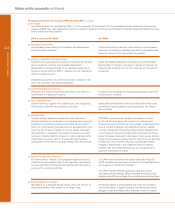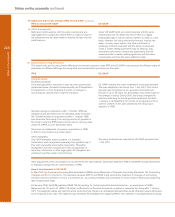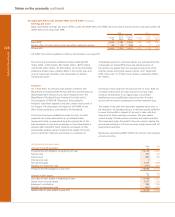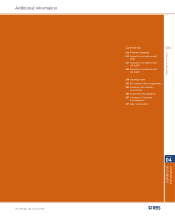RBS 2005 Annual Report Download - page 226
Download and view the complete annual report
Please find page 226 of the 2005 RBS annual report below. You can navigate through the pages in the report by either clicking on the pages listed below, or by using the keyword search tool below to find specific information within the annual report.
224
Notes on the accounts
IFRS or relevant UK GAAP
(a) Acquisition accounting
All integration costs relating to acquisitions are expensed as
post-acquisition expenses.
(b) Property revaluation and depreciation
Freehold and long leasehold property occupied for the Group's
use is carried at cost less accumulated depreciation.
Depreciation is charged based on an estimated useful life of
50 years. As permitted by IFRS 1, valuation as at 31 December
2003 is its deemed cost.
Investment properties are carried at fair value; changes in fair
value are included in the income statement.
(c) Leasehold property provisions
Provisions are raised on leasehold properties when there is a
commitment to vacate the property.
(d) Loan origination fees
Certain loan fees, together with related costs, are recognised
in the income statement as received or incurred.
(e) Pension costs
Pension scheme assets are measured at their fair value.
Scheme liabilities are measured on an actuarial basis using the
projected unit method and discounted at the current rate of
return on a high quality corporate bond of equivalent term and
currency. Any surplus or deficit of scheme assets compared
with liabilities is recognised in the balance sheet as an asset
(surplus) or liability (deficit). An asset is only recognised to the
extent that the surplus can be recovered through reduced
contributions in the future or through refunds from the scheme.
(f) Long-term assurance business
The shareholders’ interest in the long-term assurance fund is
valued as the discounted value of the cash flows expected to
be generated from in-force policies together with net assets in
excess of the statutory liabilities.
(g) Extinguishment of liabilities
Recognition of a financial liability ceases once any transfer of
economic benefits to the creditor is no longer likely.
US GAAP
Certain restructuring and exit costs incurred in the acquired
business are treated as liabilities assumed on acquisition and
taken into account in the calculation of goodwill.
Under US GAAP, revaluations of property are not permitted.
Depreciation is charged, and gains or losses on disposal are
based on the historical cost for both own-use and investment
properties.
Provisions are recognised on leasehold properties at the time
the property is vacated.
Applicable non-refundable loan fees and certain direct costs
are deferred and recognised over the period of the related
loan or facility.
US GAAP requires similar valuations but allows a certain
portion of actuarial gains and losses to be deferred and
allocated in equal amounts over the average remaining service
lives of current employees. An additional minimum liability
must be recognised if the accumulated benefit obligation (the
current value of accrued benefits without allowance for future
salary increases) exceeds the fair value of plan assets and the
Group has recorded a prepaid pension cost or has an accrued
liability that is less than the unfunded accumulated benefit
obligation. Movements in the additional minimum liability,
together with the related deferred tax, are recognised in a
seperate component of equity.
US GAAP does not permit embedded value reporting. US
GAAP requires bancassurance contracts to be classified either
as insurance or investment contracts.
US GAAP requires deferred acquisition cost and income
accounting for all contracts. Where investment contract policy
charges benefit future periods, they are deferred and amortised.
A financial liability is derecognised only when the creditor is
paid or the debtor is legally released from being the primary
obligator under the liability, either judicially or by the creditor.
(2) For 2004
As indicated above, as permitted by IFRS 1, in the preparation of the Group's 2004 consolidated income statements and balance
sheets, all IFRS have been applied except those relating to financial instruments and insurance contracts where UK GAAP principles
then current have been applied.
Notes on the accounts continued
46 Significant differences between IFRS and US GAAP (continued)
























